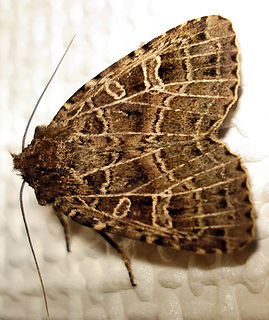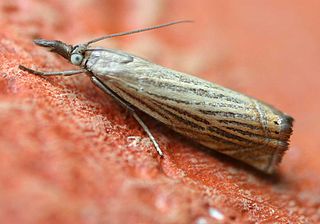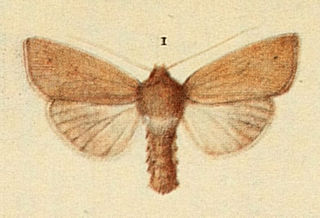
The true lover's knot is a moth of the family Noctuidae. The species was first described by Michael Denis and Ignaz Schiffermüller in 1775. It is found in the west Palearctic in a wide band through northern, central and eastern Europe and Russia. In the south it is spread through northern Spain and northern Portugal, northern Italy, Macedonia, Bulgaria, and northern Greece. In Europe it is found wherever its food plants grow. It is traditionally thought of as a species typical of heathland and moorland but it can often be found in places where heather and its relatives are in garden cultivation. In the mountains it is found up to an elevation of over 2000 metres above sea level.

The Gothic is a moth of the family Noctuidae. The species was first described by Carl Linnaeus in his 1758 10th edition of Systema Naturae. It is distributed in temperate Eurasia, in the Palearctic realm, including Europe, Turkey, Iran, Caucasus, Armenia, Transcaucasia, Central Asia, Altai mountains, and west and central Siberia.

The angle shades is a moth of the family Noctuidae. The species was first described by Carl Linnaeus in his 1758 10th edition of Systema Naturae. It is distributed throughout Europe as far east as the Urals and also in the Azores, in Algeria, and in Asia Minor, Armenia, and Syria. It is strongly migratory.

Photedes minima, the small dotted buff, is a species of moth of the family Noctuidae. It is found in Europe.

Agriphila straminella is a species of moth of the family Crambidae. It was described by Michael Denis and Ignaz Schiffermüller in 1775 and is found in Europe and east across the Palearctic.

Chrysoteuchia culmella, the garden grass-veneer, is a species of moth of the family Crambidae. It was first described by Carl Linnaeus in his 1758 10th edition of Systema Naturae. It is found in Europe.

Deilephila porcellus, the small elephant hawk-moth, is a moth of the family Sphingidae. The species was first described by Carl Linnaeus in his 1758 10th edition of Systema Naturae.

Xanthia gilvago, the dusky-lemon sallow, is a moth of the family Noctuidae. The species was first described by Michael Denis and Ignaz Schiffermüller in 1775. It is found in Europe.

Mythimna favicolor, or Mathew's wainscot, is a moth of the family Noctuidae. The species was first described by Charles Golding Barrett in 1896. It is found in Europe. The species is sometimes treated as a subspecies of Mythimna pallens, the common wainscot.

Diarsia dahlii, the barred chestnut, is a moth of the family Noctuidae. The species was first described by Jacob Hübner in 1813. It is found in Europe, through the Palearctic east to the Kamchatka Peninsula, northern China and Japan.

Xanthorhoe decoloraria, the red carpet, is a moth of the family Geometridae. The species was first described by Eugenius Johann Christoph Esper in 1806 and it is found in northern Europe, to the east across the Palearctic to Siberia and the north of North America; further south it seems to occur chiefly, if not exclusively, in the mountains.
Aureopterix sterops is a moth of the family Micropterigidae. It is known from eastern Australia, where it is known from northern Queensland, in wet coastal or elevated coastal forest between Mount Finnigan and Kirrama State Forest.
Heterocrossa sarcanthes is a moth of the Carposinidae family first described by Edward Meyrick in 1918. It is endemic to New Zealand.

Grapholita janthinana, the hawthorn leafroller, is a moth of the family Tortricidae. It was described by Philogène Auguste Joseph Duponchel in 1843. It is found in most of Europe, except most of the Balkan Peninsula, Ukraine, Lithuania and Estonia. The habitat consists of hedgerows, gardens and woodland edges.

Gynnidomorpha alismana, the water plantain conch, is a moth of the family Tortricidae. It was described by Ragonot in 1883. It is found in most of Europe, except Spain, Switzerland, most of the Balkan Peninsula and Ukraine. Further east it is found across the Palearctic to China and Korea. It is found in riverine and other watery habitats.
Lethata myrochroa is a moth of the family Depressariidae. It is found in Venezuela.
Callizyga dispar is a moth in the family Depressariidae, and the only species in the genus Callizyga. It was described by Turner in 1894 and is found in Australia, where it has been recorded from Queensland and New South Wales.
Peritornenta rhodophanes is a moth in the family Depressariidae. It was described by Edward Meyrick in 1902. It is found in Australia, where it has been recorded from Western Australia.
Peritornenta thyellia is a moth in the family Depressariidae. It was described by Edward Meyrick in 1902. It is found in Australia, where it has been recorded from Queensland and New South Wales.
Peritornenta circulatella is a moth in the family Depressariidae. It was described by Francis Walker in 1864. It is found in Australia, where it has been recorded from the Northern Territory, Queensland and New South Wales.












